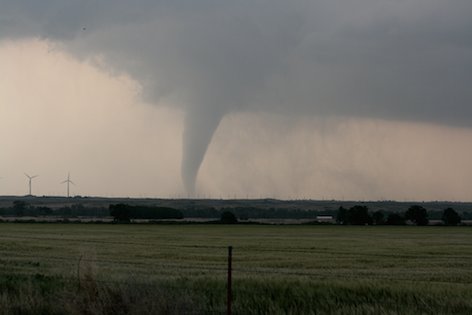
Photo courtesy of the NOAA National Severe Storms Laboratory (NSSL).
Spring has been kind to us so far, with mainly warm temperatures and tranquil skies. As Iowans, however, we know Mother Nature can quickly change her mind and bombard us with severe thunderstorms, lightning, floods and, occasionally, tornadoes.
The Environmental Health and Safety (EH&S) website contains a plethora of severe weather information, including lists of weather coordinators, evacuation maps and weather radio locations for campus buildings. The EH&S site also offers links to the National Weather Service websites and the following campus safety tips.
Severe weather
- Be aware of weather conditions at all times, especially if severe weather is predicted
- Sign up for an email or text alert from local news organizations
- Download a weather app for smart phones or mobile devices (many are free)
- If you receive a severe weather message, spread the word to your co-workers, especially those who work outside
Tornadoes
- If you hear a tornado siren while inside a building, go to a windowless interior room on the lowest level; bathrooms often are best. Avoid buildings with large expansive roof structures, like the Armory. Many campus buildings have designated storm shelters.
- If you are walking across campus and hear the tornado siren, get to the nearest building and follow the same procedures
-
If you are driving a car and debris begins flying around you, pull over and park. Your next two options are:
- ​stay in the car, buckle your seatbelt and keep your head below the windows and cover it with your hands or a blanket
- if you can safely get to a ditch or area lower than the road, exit the car, lie down and cover your head
Lightning
- If you hear thunder, lightning is close enough to harm you
- If you hear thunder -- even in the distance -- move to a safe place. Fully enclosed buildings are best. Sheds, picnic tables, tents and covered porches do not protect from lightning. If no safe buildings are nearby, get in a car (with a hard metal top) and close the windows. Stay there for at least 30 minutes after the last rumble of thunder.
- If you are planning outdoor activities, know where to go for safety and how long it will take to get there
- Consider postponing outdoor activities or moving them inside if thunderstorms are predicted
- Don't use a corded phone while there's thunder and lightning, unless it's an emergency. Cordless and cell phones are OK.
Floods
- Head to higher ground if a flash flood warning is issued for your area
- Don't drive or walk through floodwaters
-
If you live or work in a flood-prone area, be prepared to evacuate quickly and consider gathering emergency supplies, such as:
- three-day supply of nonperishable food and water
- flashlight
- seven-day supply of medications
- copies of personal documents (for example: insurance policies, birth certificates, deeds)
- cell phone with charger
- tools for securing your home
- insect repellent and sunscreen
- extra sets of car and house keys
- camera to shoot photos of damage to your property
Heat
For yourself or coworkers, know the signs of heat stress, such as:
- muscle spasms
- heavy sweating
- fainting, collapsing
- blurred vision
- weakness, fatigue
- pale, clammy skin
- dizziness
- confusion, erratic behavior
To avoid heat stress, take frequent breaks in a cool, shaded area and drink water. If symptoms appear serious, seek medical help.